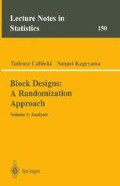Abstract
According to one of the basic principles of experimental design, the randomiza-tion principle (see Section 1.1), the experimental units (plots) are to be random-ized before they enter the experiment. Suppose that to apply a general block design, in the sense of Section 2.2, randomization is performed as described by Nelder (1954), i.e., by randomly permuting blocks within a total area of them and by randomly permuting units within the blocks. Then, assuming the usual unit-treatment additivity (in the sense of Neider, 1965b, p. 168; see also White, 1975, p. 560; Bailey, 1981, p. 215, 1991, p. 30; Kala, 1991, p. 7; Hinkelmann and Kempthorne, 1994, p. 251), and, as usual, that the technical errors are uncorrelated, each with zero expectation and a finite variance, and that they are independent of the unit responses to treatments (see Neyman, 1935, pp. 110-114 and 145; Kempthorne, 1952, p. 132 and Section 8.4; Ogawa, 1961, 1963; Hinkelmann and Kempthorne, 1994, Section 9.2.6), the model of the variables observed on the n units actually used in the experiment can be written in matrix notation as in (1.3.19), i.e., as
where y is an n x 1 vector of observed variables, T is a v x 1 vector of treatment parameters, β is a b x 1 vector of block random effects, η is an n x 1 vector of unit errors and e is an n x 1 vector of technical errors, the matrices Δ’ and D’ being defined as in Section 2.2. Properties of the model (3.1.1) can be established by following its derivation from the randomizations involved, as it has been performed for randomized blocks, the classic RBD, in Section 1.3.
Access this chapter
Tax calculation will be finalised at checkout
Purchases are for personal use only
Preview
Unable to display preview. Download preview PDF.
Author information
Authors and Affiliations
Rights and permissions
Copyright information
© 2000 Springer Science+Business Media New York
About this chapter
Cite this chapter
Caliński, T., Kageyama, S. (2000). General Block Designs and Their Statistical Properties. In: Block Designs: A Randomization Approach. Lecture Notes in Statistics, vol 150. Springer, New York, NY. https://doi.org/10.1007/978-1-4612-1192-1_3
Download citation
DOI: https://doi.org/10.1007/978-1-4612-1192-1_3
Publisher Name: Springer, New York, NY
Print ISBN: 978-0-387-98578-7
Online ISBN: 978-1-4612-1192-1
eBook Packages: Springer Book Archive

